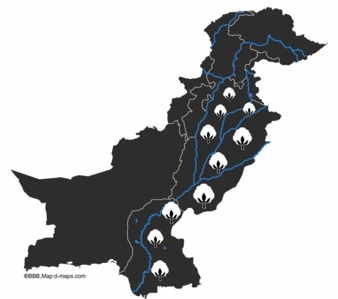22/06/2020 – Issues with seeds — auf Deutsch lesen
Pakistan: Cotton area to decrease in 2020/21
Industry contacts report that seed germination will be a major problem to maintain plant population.
Cotton is an important cash crop and lifeline of Pakistan’s textile industry. The cotton crop is planted on 14 percent of arable land during the “Kharif” or monsoon season from April to June. An estimated 1.5mn farmers grow cotton.
Poor seed germination feared
Pakistan’s MY (Aug/Jul) 2020/21 cotton production is forecast at 1.37mn tonnes. This year, the area devoted to cotton is projected to decrease to 2.2mn hectares (MHA), 12 percent lower than the last year mainly due to a shift to other remunerable crops like corn, rice, and sugarcane. Cotton area is expected to decline mainly due to the potential threat of pest attack, uncertain weather conditions, followed by insufficient availability of certified seed.
Industry contacts report that seed germination will be a major problem to maintain plant population as field tests show the range of 40 to 60 percent germination against the normal requirement of more than 80 percent. Under the current situation, the farmers must use double the seed to maintain plant population.
Cotton yields are expected to recover from the last year as only core cotton farmers are expected to grow cotton and will be utilizing their experiences to enhance productivity. MY 2020/21 yield is projected at 623 kg per hectare, 8 percent higher than the current year’s estimate of 575 kg per hectare.
High temperatures and pests reduce cotton crop
MY 2019/20 production is estimated at 1.4mn tonnes, 13 percent lower than the previous year’s production of 1.65mn tonnes. The key factors resulting in the lower production were extremely high temperatures during the critical month of September 2019, which hampered the development of fruiting bodies, severe attacks of whitefly and pink boll worms, and lower seed cotton prices.
In Pakistan, the first Bt cotton was informally introduced about 15 years ago and quickly spread before a regulatory or intellectual property system was in place to regulate it. That older event, which now covers an estimated 95 percent of cotton area, continues to dominate the biotech cotton sector, presenting a challenge to farmers due to backcrossing, weak gene expression, and growing ineffectiveness against bollworms, particularly pink bollworms. Changed legal regulations and financial incentives for research institutions should help to develop innovative seed technologies in the future.
Source: USDA/FAS Gain Report, 2 April 2020
Issue 21/22, Bremen Cotton Report




